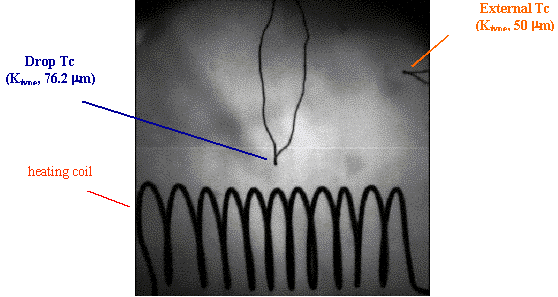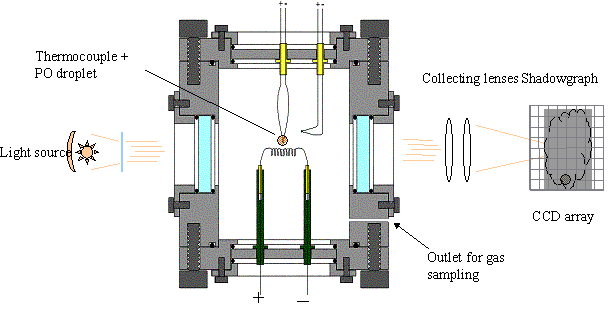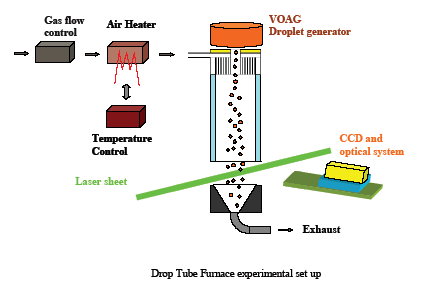 |
COMBUSTION FUNDAMENTALS OF PO OILS AND PO BASED FUELS IN LABORATORY SCALE EQUIPMENT
Different pyrolysis oils and PO-light oil emulsions have been studied in order to characterize their combustion behaviour with specific attention to ignition, emissions and influence of ageing on combustion.
Tests have been carried out using a drop tube furnace (DTF) and a single droplet combustion chamber (SDCC).
Experiments in DTF are used to study the overall combustion quality and the emissions for different fuels. Single droplet combustion chamber is used to define ignition quality and residual formation tendency of fuels.
During this first period the main features regarding the optical systems, droplets handling, gas and particulate matter sampling and analysis were defined. Different systems to ignite suspended droplets were tested. The procedure to obtain a stable spray of calibrated droplets of emulsions in the DTF was defined. A procedure to sample exhausts from the single droplet combustion chamber was established and gases and particulate matter analyses were carried out.
The systematic study on the combustion behavior of emulsions and parent fuels in the SDCC was also initiated. Tests were carried out on ten pyrolysis oil (PO) based fuels plus a diesel oil:
- four emulsions (prepared by CSGI) of PO in light oil;
- the parent oils (provided by VTT and Fortum-presently Neste Oil) and the diesel oil used to prepare the emulsions;
- a pure oil (supplied by VTT) and a mixture of the oil with ethyl alcohol;
- two Forestera™ oil samples (provided by Fortum-presently Neste Oil).
One of the Forestera™samples was also tested after 1 year aging.
The solid material, residual of the droplet's heating/vaporization, was examined by means of optical and scanning electron microscopy.
A modified version of an existing single droplet combustion chamber was arranged placing a second thermocouple transversally in the chamber in order to monitor the temperature of the environment close to the droplet. This is relevant in the definition of the ignition time because sometimes ignition starts before any luminous emission is observed.

Fuel droplets were suspended at the central thermocouple. Three different ignition systems were tested.
Light scattering/extinction and fluorescence methods were used to study soot formation and gaseous species in the flame around the droplets respectively, the shadowgraph technique to visualize the evaporation and combustion of fuel droplets. It was also designed and realized an optical system to determine the map of temperature around burning droplets.
During the tests two heating ramps were used to study the effect of a different heating rate. Solid residuals and gaseous compounds formed during the combustion were sampled and analyzed.
High speed shadowgraphy (up to 4,000 frames/sec) permitted the visualization of the different combustion phases experienced by droplets during their evolution. The picture shows the temperature of droplets of pure PO and emulsion (30% wt of PO in light oil) of similar diameter. The temperature of both droplets of PO and emulsion start to increase when the heating is switched on. Evenly, the curves present a plateau around T=130°C. This corresponds to the vaporization of the lighter compounds, mainly water, present in the PO. Thus the different duration of the plateau for pure PO and emulsion can be ascribed to the different content of water in the two fuels being emulsion formed with 30% of oil. The plateau ends with droplets ignition. A significant feature is the higher ignition temperature for PO, T = 580 °C, respect to that of emulsion, T = 420 °C. It also clearly appears the large difference in the duration of the high temperature “bell shape” region that starts at a droplet temperature above 500°C. This region corresponds to the burning of cenosphere, i.e. the carbonaceous particles formed by liquid phase pyrolysis. Thus the width of the high temperature section corresponds to the quantity of solid carbonaceous residual that is formed. Light oils have a very low tendency to form carbonaceous residuals less than 1% in wt. On the contrary, POs are very prone to form carbonaceous residuals. Thus the narrow high temperature peak, experienced by drops of emulsion, means a small residual formation and it is in agreement with the limited content of oil in the emulsion. The large high temperature peak observed in oil drop combustion corresponds to the formation of large residual.
Experiments showed that a different size distribution of the dispersed phase in PO emulsions has no influence on the thermal behaviour of the droplets.
While the size of the dispersed phase in the range of few microns is of relevance for microexplosion regime (fundamental to reduce particulate) to occur.Concerning the drop tube furnace (DTF) the activities were concentrated on the study of several alternatives for the generation of calibrated droplets of emulsions and in the definition of the most appropriate optical techniques to study droplets combustion.
The optical diagnostic system to study droplet evolution along the DTF will be based on 2D light scattering optical techniques.
Tests were carried out to define the procedure for spraying PO based emulsions. The relevant points were:
- to generate calibrated droplets;
- to verify the stability of the spray;
- to verify the erosion and corrosion of the injector;
- to define the filter choice;
- to verify the occlusion of feed ed exhaust fuel lines.
The system to produce stable sprays of emulsions was tested and procedures to produce calibrated droplets in the range 70 mm - 200 mm was defined
Gaseous compounds generated during droplets combustion were sampled and analyzed by means a gas chromatograph with flame ionization detector.
Submicronic particulate matter and ashes particles were collected by thermophoresis and deposition on small probes placed inside the chamber.
Particulate matter was examined by scanning electron microscopy and optical microscopy.
Peculiar differences were observed in the combustion of emulsions when compared with the pure pyrolysis oil (PO). The fundamental aspects concerning the link between emulsions structure (size of droplets in the disperse phase) and combustion properties started to be outlined.A further series of tests was then carried out to investigate in detail heating, vporization, swelling and microexplosion, ignition, liquid burning, cenosphere formation and the burning process.
Summarizing, fifteen PO based fuels (pure POs and emulsions) were examined in the drop tube furnace and in the single combustion chamber. For comparison also the light diesel oil utilized in the preparation of emulsions was tested. The emulsions were prepared by CSGI by using the PO provided by Fortum (presently Neste Oil) and VTT. The emulsions were characterized by different physical-chemical properties.
A database relative to heating, swelling, vaporization, ignition, liquid burning, cenosphere formation and burning processes, gaseous emissions, ageing, was formed and all the relevant parameters were recognised and correlated with the fuels properties.
The main results obtained are summarised in the following:
- Spraying: results are described in Progress/WP3/Test with a PO emulsion in a small boiler
- Ignition: Three different systems to ignite droplets were examined and compared. They permitted to vary the heating rate from about 500°C/s up to 2000 °C/s. The tests show that a higher heating rate speed up the process but the general thermal behaviour shows identical trends.
- Swelling/Microexplosion: The droplet of emulsion shows a sensible bubbling characterized by the formation of small bubbles that move toward the surface of the droplet where they explode producing small fragments. Emulsions show a strong swelling: a swelling factor SW as high as 2 is observed. The experiments indicate that the size of the dispersed phase (PO oil droplets) in the range of few microns is of relevance for determining the swelling behaviour rather than the specific size distribution. However, microexplosions are ineffective in shattering droplets.
- Heating/Evaporation: At 350°C a phase separation (PO and diesel oil) happens in the emulsion droplets and the polymerisation processes starts in the PO. This process generates heavier and more absorbing compounds inside the droplets. These compounds are responsible, at higher temperature, for the formation of cenospheres.
- Emissions Gases: Pyrolysis oils show lower light gaseous emissions respect to diesel oil. The emulsions show an intermediate behavior between PO and light oil. However, emulsions present lower total gas emissions when compared with the emissions expected on the basis of the relative amounts of parent fuels (% light diesel oil + % PO).
Tests on POs carried out in oxidizing and inert environment show that in combustion higher mass molecular species are formed with a relevant presence of aromatic compounds.
- Homogeneous combustion: The results indicate a very limited effect of the size of PO droplets in the emulsions on the combustion behaviour. The homogeneous combustion phase shows a similar trend for emulsions and diesel oil, despite the different structure of the flame and its time and spatial evolution. Thus, excluding the time to oxidize the cenosphere, a similar homogeneous burning time is observed.
- Emissions (cenospheres and ashes): The elemental analysis of cenospheres showed that they are formed essentially of carbon and oxygen, with carbon representing the more abundant species. Cenospheres from pure oil and mixture with alcohol showed essentially the same ratio C/O. This implies that the presence of alcohol does not affect the chemical reactions (liquid phase pyrolysis) responsible for cenosphere formation.
Emulsions generate small cenospheres with respect to pure PO droplets in agreement with the limited content of oil. The size of the cenosphere from emulsion droplets depends only on the fraction of oil: no influence was observed on the properties of the emulsion (size of the dispersed drops of oil, kind and percentage of surfactant, etc.). The cenosphere from an emulsion droplet is smaller to respect the cenosphere would be produced by a pure oil droplets equivalent to the oil contained in the emulsion droplet.
This can be ascribed to the large swelling of pure oil droplets (driving to the formation of large empty cenospheres) and also to the shorter duration and the lower temperature of the homogeneous combustion of emulsions droplets preceding cenospheres formation (thus limiting the polymerisation in the liquid phase responsible for the cenosphere formation). In addition, it has also to take into account the matter of emulsion escaped from the droplet due to microexplosions during the swelling phase. The burning time remains almost the same for a large range of cenospheres size. This implies that the burning rate is strongly dependent on the cenospheres dimension. This effect gives reason also for the different structure of cenospheres of different size: more compact the smaller more empty the larger. Ash was found composed mainly by carbon, oxygen, sodium, silicon and potassium with silicon and oxygen much more abundant. These two elements can reasonably derive from the sand utilized in oil production process.
- Ageing: A minor droplets swelling is observed for aged emulsions. This can be attributed to the depletion of oil in aged samples that presented a small deposit. Ageing does not influence the formation of cenosphere if not marginally: by comparing data from fresh and aged emulsion, it appears that ageing does not significantly affect the cenosphere size. The slight differences were found could be attributed to small oil deposits observed in the aged samples. Also for pure oils, it appears the slight tendency of aged samples to form smaller cenospheres.



